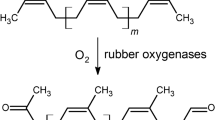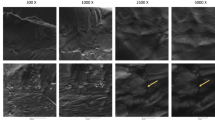Abstract
Much fundamental research has already been performed to understand the mechanism of microbial rubber degradation. Due to the increasing amount of rubber waste, biotechnical methods to degrade that particular waste are strongly needed. The present study evaluates whether a microbial or an enzymatic process is more suitable for efficient biodegradation, due to less sensitivity towards rubber additives. Therefore we investigated the impact of 15 different frequently used rubber additives on cells of the potent rubber degrader Gordonia polyisoprenivorans VH2 and the enzyme Lcp1VH2. For this, cells were grown on poly(cis-1,4-isoprene) in presence of these rubber additives. Furthermore, the effect of those additives on the enzymatic cleavage of poly(cis-1,4-isoprene) by Lcp1VH2 was determined by in vitro studies. It was observed that additives, used to accelerate the vulcanization process, like N-cyclohexyl-2-benzothiazolesulfenamide and zinc-bis(N,N-dibenzyl-dithiocarbamate), are diminishing the growth of the microorganism depending on their concentration—higher toxicity with increasing concentration. In contrast, sulfur prevents cell growth, but does not affect Lcp1VH2. Stearic acid and paraffin wax were found to be consumed by G. polyisoprenivorans VH2. Plasticizers mainly prevent growth, but do not interfere with the enzyme activity. This study identified antioxidants as the most interfering group of additives for microbial and enzymatic rubber degradation. It was found that the in vitro degradation by Lcp1VH2 is much more resistant and less sensitive towards the investigated rubber additives, when compared to the in vivo approach. Therefore, an enzymatic process might be a promising method to enhance rubber degradation.

Similar content being viewed by others
References
Andler R, Steinbüchel A (2017) A simple, rapid and cost-effective process for production of latex clearing protein to produce oligoisoprene molecules. J Biotechnol 241:184–192. https://doi.org/10.1016/j.jbiotec.2016.12.008
Andler R, Altenhoff A-L, Mäsing F, Steinbüchel A (2018) In vitro studies on the degradation of poly(cis-1,4-isoprene). Biotechnol Prog. https://doi.org/10.1002/btpr.2631
Berekaa MM, Linos A, Reichelt R, Keller U, Steinbüchel A (2000) Effect of pretreatment of rubber material on its biodegradability by various rubber degrading bacteria. FEMS Microbiol Lett 184(2):199–206
Bindiya ES, Roselin A, Cikesh PC, Karthikeyan P, Sarita GB, Chandrasekaran M (2014) Antibacterial potential of Luprops tristis—the nuisance rubber plantation pest from Western Ghats of India. IJAIR 3(6):2278–7844
Birke J, Jendrossek D (2014) Rubber oxygenase and latex clearing protein cleave rubber to different products and use different cleavage mechanisms. Appl Environ Microbiol 80(16):5012–5020
Christiansson M, Stenberg B, Holst O (2000) Toxic additives—a problem for microbial waste rubber desulphurisation. Resour Environ Biotechnol 3(1):11–21
Davies JR, Kam FW (1968) Identification of antioxidants and accelerators in gum and carbon black filled rubbers by thin-layer chromatography. IRI 2:86
De Miguel T, Sieiro C, Poza M, Villa TG (2000) Isolation and taxonomic study of a new canthaxanthin-containing bacterium, Gordonia jacobaea MV-1 sp. nov. Int Microbiol 3:107–111
Fachgruppe Wasserchemie in d. GDCh, Frimmel F, Forstner U, Raudschus M, Reicher JK (1996) Chemie und Biologie der Altlasten. In: Obst U, Seibel F (eds) Biologische und ökologische Grundlagen, 1st edn. Wiley-VCH, Weinheim, p 59. ISBN 3-527-28802-3
Hiessl S, Schuldes J, Thürmer A, Halbsguth T, Bröker D, Angelov A, Liebl W, Daniel R, Steinbüchel A (2012) Involvement of two latex-clearing proteins during rubber degradation and insights into the subsequent degradation pathway revealed by the genome sequence of Gordonia polyisoprenivorans Strain VH2. Appl Environ Microbiol 78:2874–2887
Hiessl S, Böse D, Oetermann S, Eggers J, Pietruszka J, Steinbüchel A (2014) Latex clearing protein—an oxygenase cleaving poly(cis-1,4-isoprene) rubber at the cis double bonds. Appl Environ Microbiol 80:5231–5240
Holst O, Stenberg B, Christiansson M (1998) Biotechnological possibilities for waste tyre rubber treatment. Biodegradation 9:301–310
Ibrahim EMA, Arenskötter M, Luftmann H, Steinbüchel A (2006) Identification of poly(cis-1,4-isoprene) degradation intermediates during growth of moderately thermophilic actinomycetes on rubber and cloning of a functional lcp homologue from Nocardia farcinica strain E1. Appl Environ Microbiol 72(5):3375–3382
Kan T, Strezov V, Evans T (2017) Fuel production from pyrolysis of natural and synthetic rubbers. Fuel 191:403–410
Nadarajah M, Irimanne ASLT, Oomarasamy AC, Kasinathan S (1971) Some naturally occurring antioxidants in Hevea Brasiliensis Latex. Q Jl Rubb Ret Inil Ceylon 48:202–211
Nowaczyk K, Domak F (1999) Attempts at microbiological utilization of rubber wastes. Pol J Environ Stud 8(2):101–106
Onokpise O, Louime C (2012) The potential of the South American leaf blight as a biological agent. Sustainability 4:3151–3157
Pfennig N (1974) Rhodopseudomonas globiformis, sp. n., a new species of the Rhodospirillaceae. Arch Microbiol 100:197–206
Rose K, Tenberge KB, Steinbüchel A (2004) Identification and characterization of genes from Streptomyces sp. strain K30 responsible for clear zone formation on natural rubber latex and poly(cis-1,4-isoprene) rubber degradation. Biomacromol 6:180–188
Schlegel HC, Kaltwasser H, Gottschalk G (1961) Ein Submersverfahren zur Kultur wasserstoffoxydierender Bakterien: Wachstumsphysiologische Untersuchungen. Arch Microbiol 38:209–222
Schmitt G, Seiffert G, Kroneck PMH, Braaz R, Jendrossek D (2010) Spectroscopic properties of rubber oxygenase RoxA from Xanthomonas sp., a new type of dihaem dioxygenase. Microbiology (SGM) 156:2537–2548
Sofi A (2017) Effect of waste tyre rubber on mechanical and durability properties of concrete—a review. ASEJ. https://doi.org/10.1016/j.asej.2017.08.007
Tsuchii A, Takeda K (1990) Rubber-degrading enzyme from a bacterial culture. Appl Environ Microbiol 56(1):269–274
Tsuchii A, Tokiwa Y (2005) Two-step cultivation method for microbial disintegration of tire rubber particles. J Polym Environ 13:75–80
Tsuchii A, Suzuki T, Takeda K (1985) Microbial degradation of natural rubber vulcanizates. Appl Environ Microbiol 50(4):965–970
Warneke S, Arenskötter M, Tenberge KB, Steinbüchel A (2007) Bacterial degradation of poly(trans-1,4-isoprene (gutta percha). Microbiology (SGM) 153:347–356
http://www.statista.com. https://de.statista.com/statistik/daten/studie/200677/umfrage/weltweiter-verbrauch-von-natur-und-synthetischem-kautschuk-seit-1990/. Weltweiter Verbrauch von Natur- und synthetischem Kautschuk in den Jahren 1990 bis 2016 (2018)
Williams GR (1986) The biodeterioration of vulcanized rubbers. Int Biodeterior Biodegrad 22:307–311
Yikmis M, Steinbüchel A (2012) Historical and recent achievements in the field of microbial degradation of natural and synthetic rubber. Appl Environ Microbiol 78(13):4543–4551
Acknowledgements
We thank Vibracoustic GmbH and Freudenberg Technology Innovation SE & Co. KG for financial support and for providing the rubber additives for our studies on the impact of commonly used rubber chemicals on the microbial and enzymatic degradation of poly(cis-1,4-isoprene).
Author information
Authors and Affiliations
Corresponding author
Electronic supplementary material
Below is the link to the electronic supplementary material.
Rights and permissions
About this article
Cite this article
Altenhoff, AL., de Witt, J., Andler, R. et al. Impact of additives of commercial rubber compounds on the microbial and enzymatic degradation of poly(cis-1,4-isoprene). Biodegradation 30, 13–26 (2019). https://doi.org/10.1007/s10532-018-9858-5
Received:
Accepted:
Published:
Issue Date:
DOI: https://doi.org/10.1007/s10532-018-9858-5




